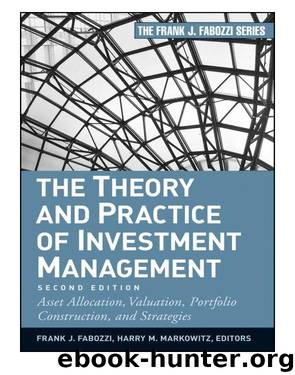The Theory and Practice of Investment Management by Frank J. Fabozzi & Markowitz Harry M

Author:Frank J. Fabozzi & Markowitz, Harry M.
Language: eng
Format: epub
Publisher: Wiley
Published: 2011-04-14T04:00:00+00:00
KEY POINTS
• The equity security underlying an equity derivative can be a stock, a basket of stocks, an index or a group of indexes.
• Equity derivatives have four basic roles: risk management, returns management, cost management and regulatory management.
• There are three segments of the equity derivatives market: exchange-listed market, OTC market and the market for structured products.
• There are three general categories of derivatives: futures and forwards, options and swaps.
• OTC derivatives provide more flexible terms than listed derivatives and can be customized to meet the specific needs of investors.
• The listed market has sought to incorporate products with OTC characteristics such as FLEX options and binary options.
• The fundamental difference between futures and options is that the buyer of an option has the right but not the obligation to perform whereas the seller of an option is obligated to perform; in contrast, in the case of a futures contract both parties are required to perform
• The payout structure of a futures contract and an options contract differ. The price of an option contract represents the cost of eliminating or modifying the risk–reward relationship of the underlying. The payout for a futures contract is a dollar-for-dollar gain or loss for the buyer and seller. Consequently, a futures payout is symmetrical, while the payout for options is skewed.
• The Black-Scholes model is the basic options pricing model. There are many extensions of this model, but it remains the basic model in practice.
• The factors that affect an option’s price are (1) spot price of the underlying, (2) strike price, (3) time to expiration of the option, (4) expected price volatility of the underlying over the life of the option, (5) shortterm risk-free rate over the life of the option, and (6) anticipated cash dividends on the underlying stock or index over the life of the option.
• In employing options in investment strategies, a portfolio manager can calculate the sensitivity of the price of an option to a change in any one of the factors that affect its price.
• There are numerous stock index futures contracts that have been developed around the world that can be used to implement an equity investment strategy.
• Single stock futures contracts trade around the world including on the OneChicago exchange in the United States.
• Futures can be priced using a cost of carry valuation model.
• The OTC derivatives market includes equity forwards, options and warrants, equity linked debt and equity swaps.
• Structured products are an extension of the OTC market and can include a “wrapper” to house the product and sell in to the public.
Download
This site does not store any files on its server. We only index and link to content provided by other sites. Please contact the content providers to delete copyright contents if any and email us, we'll remove relevant links or contents immediately.
Rich Dad Poor Dad by Robert T. Kiyosaki(6174)
Pioneering Portfolio Management by David F. Swensen(6078)
How To Win Friends and Influence People by Dale Carnegie(4332)
The Money Culture by Michael Lewis(3846)
The Dhandho Investor by Mohnish Pabrai(3560)
The Wisdom of Finance by Mihir Desai(3523)
Liar's Poker by Michael Lewis(3220)
The Intelligent Investor by Benjamin Graham Jason Zweig(2930)
The ONE Thing by Gary Keller(2918)
Mastering Bitcoin: Programming the Open Blockchain by Andreas M. Antonopoulos(2891)
Fooled by Randomness: The Hidden Role of Chance in Life and in the Markets by Nassim Nicholas Taleb(2860)
Rich Dad Poor Dad: What The Rich Teach Their Kids About Money - That The Poor And Middle Class Do Not! by Robert T. Kiyosaki(2834)
Investing For Dummies by Eric Tyson(2793)
How to Win Friends and Influence People by Dale Carnegie(2793)
How to Day Trade for a Living: Tools, Tactics, Money Management, Discipline and Trading Psychology by Andrew Aziz(2785)
Market Wizards by Jack D. Schwager(2538)
Zero Hour by Harry S. Dent Jr. & Andrew Pancholi(2531)
How to Pay Zero Taxes, 2018 by Jeff A. Schnepper(2498)
Rich Dad's Guide to Investing by Robert T. Kiyosaki(2410)
